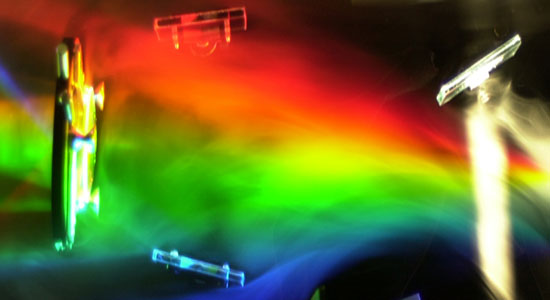RIT launches color science Ph.D.
Submitted by Mark Fairchild
This rendition of the color spectrum allows some insight into how a digital camera system reads color in what looks like discrete regions of red, green and blue.
Color science provides standards of measurement and quality control to make sure one batch of red iPods is the same shade as the next, that a can of kiwi-colored paint is as brilliant as the sample chip in the paint store, and that the print in your hand matches the digital image on your computer screen.
In fall 2007, RIT will offer a new doctoral degree in color science, the only one of its kind in the world. This specialized field blends physics, chemistry and visual perception, among other sciences, to quantify how the human eye perceives color—to translate color into scientific data. “You look around and you see a chromatic world,” says Roy Berns, program coordinator and the Richard S. Hunter Professor of Color Science, Appearance and Technology at RIT. “We put numbers on those perceptions important for commerce as well as for using color as scientific data. We study how changes in the building blocks of color, such as lighting, materials and the observer, change those perceptions and change those numbers.” A variety of industries depend on color science research, especially those that center around manufacturing colored products, printing, digital photography and cinema, computer graphics and animation, art conservation, and medical data visualization and diagnoses. Advances in technology that give us plasma displays, for instance, rely upon consistent color control to translate reds, greens and blues from a signal to the screen and from one program, movie or commercial to the next. Color science provides a way to measure those interpretations to consistently produce the desired colors.
The doctorate in color science is an extension of the existing graduate program offered by RIT’s Chester F. Carlson Center for Imaging Science. It is designed for students with undergraduate majors in physics, chemistry, mathematics, computer science, engineering, experimental psychology, and imaging, as well as textiles, graphic arts, animation, material science and polymer science. Students will learn how to address problems in the measurement, production, formulation, reproduction and perception of color. The curriculum combines required courses in color science, elective courses, a research project during the second year of study and a dissertation. “The main thing is that it will allow us to have a wider variety of students from more diverse educational backgrounds because it expands the range of research we can do with students,” says Mark Fairchild, director of the Munsell Color Science Laboratory at RIT, a leading academic laboratory dedicated to color science education and research. Berns adds: “The way we teach color science here has always been interdisciplinary. We’re trying to foster that into the color science Ph.D. both from a student and a departmental perspective.” RIT’s Ph.D’s Color science joins three other programs at the doctorate level: imaging science (1988), microsystems (2002) and computing and information sciences (2005).
Astrophysics is currently under RIT internal review. Sustainability is currently in the design stage. Applicants to the doctoral program are being accepted for fall 2007. For information, contact Berns at berns@cis.rit.edu or 475-2230.















